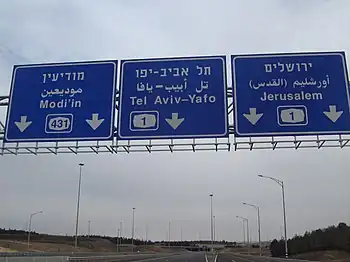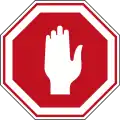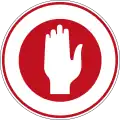
Road signs in Israel are regulated by the Ministry of Transportation in the Division of Transportation Planning, most recently set forth in June 2011.[1]
They generally use the same pattern of colors, shapes, and symbols set out in the Vienna Convention on Road Signs and Signals, which are also used in most countries of Europe and the Middle East. Despite this, Israel is not a signatory to this convention.
Language
Signs employ three scripts – Hebrew, Arabic, and Latin – and are written in Hebrew and Arabic, the two official languages of the country, and in English.
The stop sign, however, instead of displaying words in three languages, or even just in English as required by the Vienna Convention on Road Traffic, conveys its meaning through the depiction of a raised hand.
Font
Israeli road sign regulations provide for the following fonts to be used: Tamrurim for Hebrew script, Medina for Arabic script, and Triumvirat (a Helvetica derivative) for Latin script as well as numbers.[2] However, these rules are not consistently followed; some signs use Highway Gothic or Clearview for the Latin script.
Warning signs
Signs warning of hazardous conditions or dangerous situations bear a black-on-white symbol inside a red-bordered triangle.
- Signs giving warnings
 Uneven road
Uneven road Sharp right curve
Sharp right curve Sharp left curve
Sharp left curve Curve right and then left
Curve right and then left Curve left and then right
Curve left and then right Winding road ahead
Winding road ahead Barriers
Barriers Barriers
Barriers Road narrows ahead
Road narrows ahead Road narrows from right ahead
Road narrows from right ahead Road narrows from left ahead
Road narrows from left ahead Barriers
Barriers Barriers
Barriers Barriers
Barriers Intersection
Intersection Side road on the right ahead
Side road on the right ahead Side road on the left ahead
Side road on the left ahead T-intersection
T-intersection Barriers
Barriers Staggered crossroads
Staggered crossroads Staggered crossroads
Staggered crossroads Roundabout ahead
Roundabout ahead Traffic signal ahead
Traffic signal ahead Minor road merging from the right
Minor road merging from the right Minor road merging from the left
Minor road merging from the left Merge with major road from the right
Merge with major road from the right Merge with major road from the left
Merge with major road from the left Possible traffic congestion
Possible traffic congestion Traffic congestion ahead
Traffic congestion ahead Tram crossing ahead
Tram crossing ahead Railroad crossing ahead
Railroad crossing ahead Pedestrian crosswalk
Pedestrian crosswalk Pedestrians nearby
Pedestrians nearby Bicycle traffic crossing
Bicycle traffic crossing Stop sign ahead
Stop sign ahead Dangerous descent
Dangerous descent Danger of skidding
Danger of skidding Rock slide zone
Rock slide zone Rock slide zone
Rock slide zone
 Speed breaker
Speed breaker Two-way traffic
Two-way traffic
 Farm vehicles crossing
Farm vehicles crossing Children or school crosswalk
Children or school crosswalk Road works
Road works End of road works
End of road works Flooded road
Flooded road
Regulatory signs
With the exception of the special shapes used for "Stop" and "Yield" signs (respectively, an octagon and a downward-pointing triangle), signs giving orders are circular and are of two kinds:
- Mandatory signs (e.g. "Turn right only") bear a white symbol on a blue disk.
- Prohibitory signs (e.g. "No left turn") take the form of a black-on-white symbol inside a red-bordered circle, sometimes with the addition of a red slash through the symbol.
- Mandatory signs
 Go straight or turn right
Go straight or turn right Go straight or turn left
Go straight or turn left Go straight
Go straight Turn right
Turn right Turn left
Turn left Turn right or left
Turn right or left Go straight or make right U-turn
Go straight or make right U-turn Go straight or make left U-turn
Go straight or make left U-turn Compulsory right U-turn
Compulsory right U-turn Compulsory left U-turn
Compulsory left U-turn May pass on either sign
May pass on either sign Pass on the right
Pass on the right Pass on the left
Pass on the left Start of motorway
Start of motorway End of motorway
End of motorway Minimum speed limit
Minimum speed limit Road for motor vehicles only
Road for motor vehicles only Start of traffic calming area
Start of traffic calming area End of traffic calming area
End of traffic calming area Traffic recession area
Traffic recession area End of traffic recession area
End of traffic recession area Cycle lane
Cycle lane End of cycle lane
End of cycle lane Pedestrian path
Pedestrian path Cycle path
Cycle path Shared pedestrian and cycle path
Shared pedestrian and cycle path Segregated pedestrian and cycle path
Segregated pedestrian and cycle path Toll lane or toll road
Toll lane or toll road End of toll lane or toll road
End of toll lane or toll road
- Signs giving orders
 Give way
Give way Stop
Stop
 Stop (manual control)
Stop (manual control) Go (manual control)
Go (manual control) Yield to oncoming traffic
Yield to oncoming traffic Priority over oncoming traffic
Priority over oncoming traffic Priority road
Priority road End of priority road
End of priority road Closed to all vehicles
Closed to all vehicles No entry
No entry Barriers
Barriers Barriers
Barriers Cars and motorbikes prohibited
Cars and motorbikes prohibited No trucks weighing over 10 tonnes
No trucks weighing over 10 tonnes Vehicles transporting hazardous materials prohibited
Vehicles transporting hazardous materials prohibited Cars prohibited
Cars prohibited Motorbikes prohibited
Motorbikes prohibited Tractors and work vehicles prohibited
Tractors and work vehicles prohibited Animals prohibited
Animals prohibited Bicycles prohibited
Bicycles prohibited Pedestrians prohibited
Pedestrians prohibited Pedestrians, bicycles, work transport and animals prohibited
Pedestrians, bicycles, work transport and animals prohibited No vehicles weighing over 6 tonnes
No vehicles weighing over 6 tonnes No vehicles higher than 4.6 meters
No vehicles higher than 4.6 meters No vehicles wider than 2.1 meters
No vehicles wider than 2.1 meters No driving lessons zone
No driving lessons zone End of no driving lessons zone
End of no driving lessons zone No overtaking
No overtaking End of no overtaking
End of no overtaking Overtaking is prohibited for large vehicles
Overtaking is prohibited for large vehicles End of no overtaking for large vehicles
End of no overtaking for large vehicles Urban area
Urban area End of urban area
End of urban area Speed limit (50 km/h)
Speed limit (50 km/h) Speed limit (50 km/h)
Speed limit (50 km/h) End of speed limit (50 km/h)
End of speed limit (50 km/h) No right turn ahead
No right turn ahead No left turn ahead
No left turn ahead No right U-turn
No right U-turn No left U-turn
No left U-turn Parking prohibited
Parking prohibited Parking and stopping prohibited
Parking and stopping prohibited End of parking prohibition
End of parking prohibition Parking of trucks weighing over 10,000 kg prohibited
Parking of trucks weighing over 10,000 kg prohibited End of parking prohibition of trucks weighing over 10,000 kg
End of parking prohibition of trucks weighing over 10,000 kg Customs
Customs
Information signs
Signs giving information are generally rectangular (sometimes pointed at one end in the case of direction signage).
Highways in Israel are classified as:
- National (single-digit number)
- Inter-city (two digits)
- Regional (three digits)
- Local (four digits)
Route-marker signs are also color-coded:
- Freeways (Blue)
- Expressways (Red)
- Regional routes (Green)
- Local roads (Black, formerly Brown)
Most directional signs to towns and cities are:
- white-on-blue (freeways)
- white-on-green (other main roads)
- black-on-white (local destinations)
- white-on-brown (tourist destinations: landmarks, historical sites, nature reserves, etc.).
The sign for permitted parking features a white-on-blue "P" for "parking" enclosed by the Hebrew letter Het ("ח") for "hanaya" (Hebrew: חניה), which also means "parking").
The sign informing users that they are on a priority road is a white-edged yellow "diamond" (i.e. a square turned through 45°).
- Information signs
 National Freeway (1 digit)
National Freeway (1 digit) National Freeway which is also an Inter-City Expressway (1 digit)
National Freeway which is also an Inter-City Expressway (1 digit) National Inter-City Expressway (1 digit)
National Inter-City Expressway (1 digit) Inter-City Expressway (2 digits)
Inter-City Expressway (2 digits) National Expressway (2 digit)
National Expressway (2 digit) Regional roads (3 digits)
Regional roads (3 digits) Local roads (4 digits)
Local roads (4 digits) Freeway sign
Freeway sign Major road sign
Major road sign Local destination sign
Local destination sign Tourist destination sign
Tourist destination sign Street sign
Street sign Entry to toll
Entry to toll Parking (sign can be two-sided)
Parking (sign can be two-sided) Handicapped parking
Handicapped parking Pedestrian crossing
Pedestrian crossing Exit sign
Exit sign One-way traffic
One-way traffic Border sign
Border sign No through road
No through road No through road on right
No through road on right No through road on left
No through road on left Tunnel
Tunnel End of tunnel
End of tunnel
References
- ↑ Traffic Sign Sheet, Ministry of Transportation, July 2012
- ↑ "הנחיות לתכנוןשילוט בדרכים בין-עירוניות מהדורה2016" (PDF). gov.il.
External links
 Media related to Road signs in Israel at Wikimedia Commons
Media related to Road signs in Israel at Wikimedia Commons